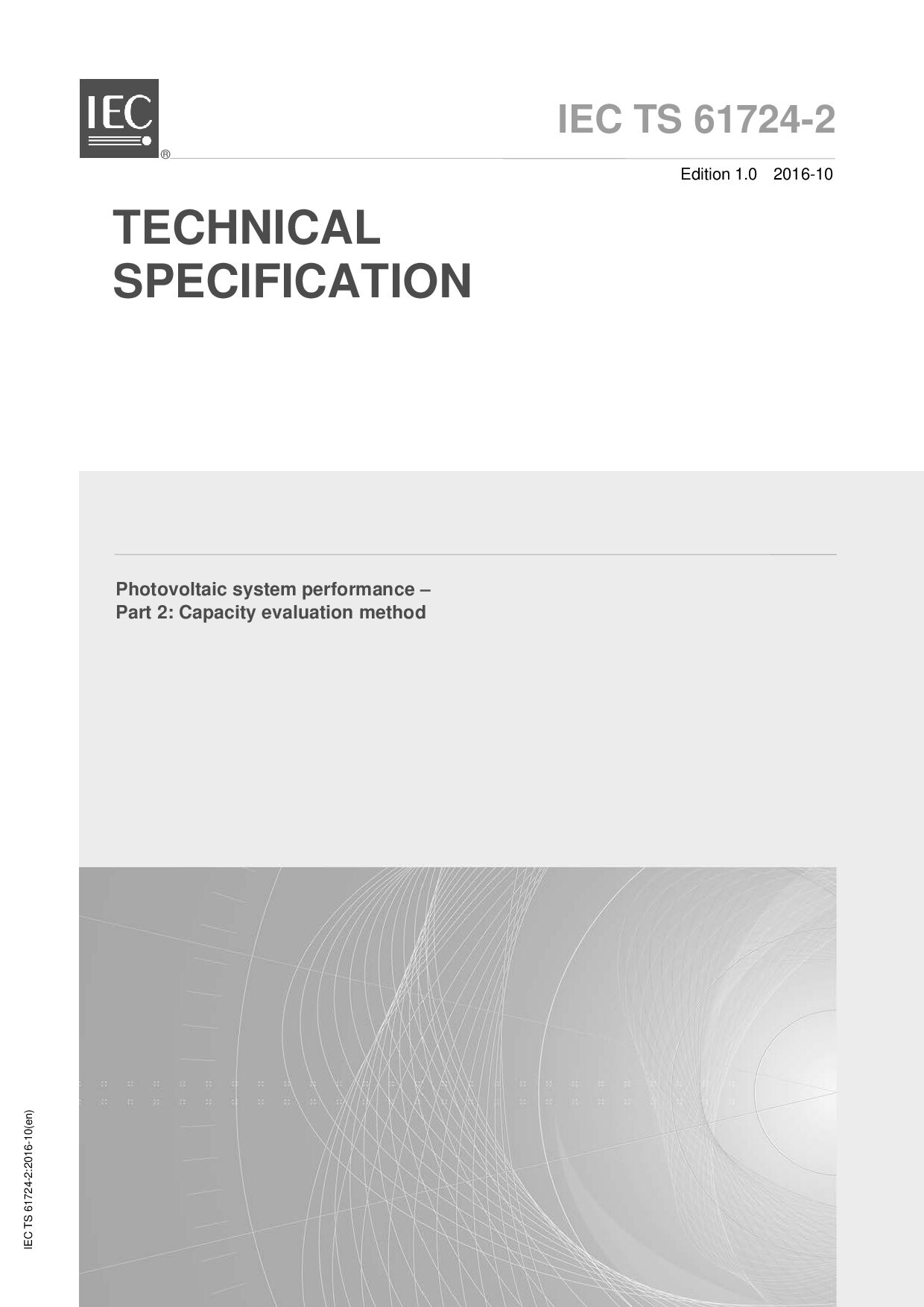IEC TS 61724-2-2016
Photovoltaic system performance - Part 2: Capacity evaluation method
IEC TS 61724-2-2016 发布历史
This part of IEC 61724 defines a procedure for measuring and analyzing the power production of a specific photovoltaic system with the goal of evaluating the quality of the PV system performance. The test is intended to be applied during a relatively short time period (a few relatively sunny days). In this procedure, actual photovoltaic system power produced is measured and compared to the power expected for the observed weather based on the design parameters of the system. The expected power under reference and measured conditions are typically derived from the design parameters that were used to derive the performance target for the plant as agreed to prior to the commencement of the test. For cases when a power model was not developed during the plant design, a simple model that increases transparency is presented in the annexes as a possible approach. The intent of this document is to specify a framework procedure for comparing the measured power produced against the expected power from a PV system on relatively sunny days. This test procedure is intended for application to grid-connected photovoltaic systems that include at least one inverter and the associated hardware. The performance of the system is quantified both during times when the inverters are maximum-power-point tracking and during times when the system power is limited by the output capability of the inverter or interconnection limit, reducing the system output relative to what it would have been with an inverter with generation freely following irradiance, if this condition is relevant. This procedure can be applied to any PV system, including concentrator photovoltaic systems, using the irradiance (direct or global) that is relevant to the performance of the system. This test procedure was designed and drafted with a primary goal of facilitating the documentation of a performance target, but it can also be used to verify a model, track performance (e. g., degradation) of a system over the course of multiple years, or to document system quality for any other purpose. The terminology has not been generalized to apply to all of these situations, but the intent is to create a methodology that can be used whenever the goal is to verify system performance at a specific reference condition chosen to be a frequently observed condition. A more complete evaluation of plant performance can be accomplished by using the complementary Technical Specification IEC TS 61724-3, Photovoltaic system performance - Part 3: Energy evaluation method.
IEC TS 61724-2-2016由国际电工委员会 IX-IEC 发布于 2016-10。
IEC TS 61724-2-2016在国际标准分类中归属于: 27.160 太阳能工程。
IEC TS 61724-2-2016 发布之时,引用了标准
- ASME PTC 19.1-2013 试验不确定度*, 2022-12-17 更新
- IEC 61724-1 光伏系统性能.第1部分:监测*, 2021-07-21 更新
- ISO/IEC GUIDE 98-1-2009 测量不确定度.第1部分: 测量中不确定度的表示介绍*, 2022-12-17 更新
* 在 IEC TS 61724-2-2016 发布之后有更新,请注意新发布标准的变化。
IEC TS 61724-2-2016的历代版本如下:
- 2016年10月 IEC TS 61724-2-2016
- 标准号
- IEC TS 61724-2-2016
- 发布日期
- 2016年10月
- 实施日期
- 废止日期
- 无
- 国际标准分类号
- 27.160
- 发布单位
- 国际电工委员会
- 引用标准
- ASME PTC 19.1-2013 IEC 61724-1 IEC/TS 61836-2007 ISO/IEC GUIDE 98-1-2009
- 被代替标准
- IEC 82/1101/DTS-2016
- 适用范围
- This part of IEC 61724 defines a procedure for measuring and analyzing the power production of a specific photovoltaic system with the goal of evaluating the quality of the PV system performance. The test is intended to be applied during a relatively short time period (a few relatively sunny days). In this procedure, actual photovoltaic system power produced is measured and compared to the power expected for the observed weather based on the design parameters of the system. The expected power under reference and measured conditions are typically derived from the design parameters that were used to derive the performance target for the plant as agreed to prior to the commencement of the test. For cases when a power model was not developed during the plant design, a simple model that increases transparency is presented in the annexes as a possible approach. The intent of this document is to specify a framework procedure for comparing the measured power produced against the expected power from a PV system on relatively sunny days. This test procedure is intended for application to grid-connected photovoltaic systems that include at least one inverter and the associated hardware. The performance of the system is quantified both during times when the inverters are maximum-power-point tracking and during times when the system power is limited by the output capability of the inverter or interconnection limit, reducing the system output relative to what it would have been with an inverter with generation freely following irradiance, if this condition is relevant. This procedure can be applied to any PV system, including concentrator photovoltaic systems, using the irradiance (direct or global) that is relevant to the performance of the system. This test procedure was designed and drafted with a primary goal of facilitating the documentation of a performance target, but it can also be used to verify a model, track performance (e. g., degradation) of a system over the course of multiple years, or to document system quality for any other purpose. The terminology has not been generalized to apply to all of these situations, but the intent is to create a methodology that can be used whenever the goal is to verify system performance at a specific reference condition chosen to be a frequently observed condition. A more complete evaluation of plant performance can be accomplished by using the complementary Technical Specification IEC TS 61724-3, Photovoltaic system performance - Part 3: Energy evaluation method.
